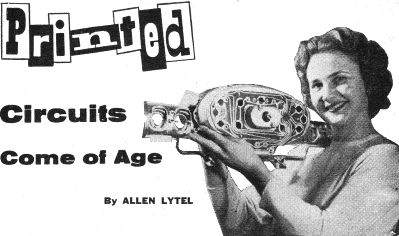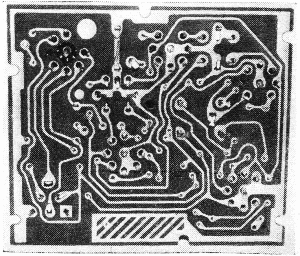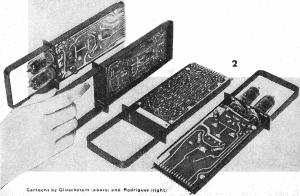|
December 1957 Popular Electronics
 Table
of Contents Table
of Contents
Wax nostalgic about and learn from the history of early electronics. See articles
from
Popular Electronics,
published October 1954 - April 1985. All copyrights are hereby acknowledged.
|
There is a twofer on this
page - a feature article and a couple related electronics-themed comics. Point-to-point
wiring of electronics assemblies is rarely seen these days. For that matter, the
use of leaded components is rarely seen these days. The advent of printed circuit
boards was a real breakthrough concept when they became commercially viable in the
1950s. As the comic at the bottom of the page suggests, many people did not even
know what a printed circuit board was.
The air traffic control radar unit that I worked on in the USAF had all point-to-point
wiring in a trailer-full of chassis. Terminal strips and bus strips, bifurcated
terminals, tube socket terminals, and studs from relays and switches were the connection
points that the leaded components and wiring stretched between. Compared to a PCB
(especially multi-layered through-hole), servicing those assemblies was a piece
of cake!
Printed Circuits Come of Age
By Allen Lytel

PRINTED circuits have come of age. Today they are an integral part of almost
all electronic equipment. Look at the nearest device: if it has been made in the
past year, the chances are that in it you will find printed circuits or components.
Some of the newest uses for printed circuits are in the instrument cluster con-nections
in an auto dashboard (see photo above). Guided missiles have compact, reliable controls
which use printed circuits, and so do midget tape recorders, jet planes, hearing
aids, electronic organs, and hun-dreds of other devices.
The most common type is an insulating board* with a pattern of conducting wires
(below right). A photo or printing process transfers the design to the copper-clad
base and an etching process removes the excess copper, leaving the circuit. In other
methods, the conductors are built up on the insulated base. Next step is the placement
of components, handled mechanically. In one machine all heads are controlled simultaneously,
and as the board is positioned, all the capacitors and resistors are inserted in
one operation. In another machine, they are inserted one at a time as the board
moves down the line. After the components are inserted, all parts are dip-soldered
in place in a single operation.

Printed Circuit Board (PCB)
 Figure 1
 Figure 2
 Figures 3, 4, and 5
The use of printed circuits has led to the development of modules. These are
complete circuits such as audio amplifiers, cathode followers or pulse generators.
Modules are built on a single board as a unit, acting as a standard circuit which
can be used in different end products. Figure 1 on the next page shows an experimental
TV receiver built of 17 modules which hold 153 of the 195 components (resistors,
capacitors, etc.) exclusive of the tuner. Other modular construction is of the type
in Fig. 2. These are plug-in boards as used in many computers and industrial
controls. Tube and tubeless types with diodes are shown.
These modules can be made up of smaller units. For example, several resistors
and capacitors can make up a package -- a "super component" -- and can be used on
a printed-circuit board (Fig. 3). In another way of treating the same situation,
the components are encapsulated in phenolic material (Fig. 4).
The newest development is flat Tape Cable (Fig. 5) which eases the task
of interconnecting printed wiring (see October issue of POPULAR ELECTRONICS, p.
72).

"Those the printed circuits you hear about?"

"If this works, you'll make hearing aid history -"
These Technically-Themed Comics Appeared in Vintage Electronics Magazines.
I personally scanned and posted every one from copies I own (and even colorized
some). 235 pages as of 6/28/2024
|
|
|
|
Posted September 30, 2019
(updated from original post on 7/10/2011)
|
